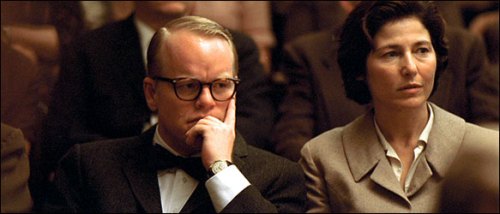 |
| Scene from Capote film. From left, Characters: Capote and Harper Lee |
Truman Capote's final masterpiece, In Cold Blood is a piece of non-fiction literature based on the mass murder of a well-respected family in Holcomb, Kansas. When Capote read an article about the Clutter case in the New York Times, he knew he had found his next subject. Capote believed he was meant to tell the story of the seemingly motiveless crime. He travelled to Kansas with friend and writer, Harper Lee, and immersed himself in the Holcomb community for five years hoping to understand what happened on November 15, 1959 at the Clutter farm.
Capote's writing is extremely vivid and descriptive. I believe his careful attention to detail is what makes this book about a brutal crime so readable. He brings the small town to life in his first sentence, "The village of Holcomb stands on the high wheat plains of western Kansas, a lonesome area that other Kansans call "out there." I thought this single sentence painted a picture of the small town where the Clutter's lived and why the crime uprooted the entire community.
Personally, watching the film Capote really made the novel come alive even though the text accounts nearly everything that happens during the case and trial period. Philip Seymour Hoffman's portrayal of Truman Capote makes the film. I truly gained a sense of what Truman Capote must have been like and how the Kansans' viewed him.
Like he mentions several times in the movie, Capote had a photographic memory that allowed him to recall conversations with incredible accuracy. Once the people of Holcomb accepted Capote's idiosyncrasies, he was able to form valuable relationships that gave him more access to information about the crime. Capote amassed more information about the people, places, and events connected to the crime than he needed.
Capote requested permission to talk to the suspects Perry Smith and Dick Hickock in their jail cells. His understanding of Dick and Perry, makes his work more than just reportage of a crime. Capote allows readers to evaluate Perry and Dick on their own accords based on the background information he reveals. The book and the movie both make Perry seem like the less harmful character, even though he is the one who killed four members of the Clutter family. Readers inevitably sympathize with Perry as Capote writes about his troubled upbringing in great detail.
After watching the film, I can better imagine the nature of Capote and Perry's relationship. Capote really wanted to understand how such a sensitive, quiet man like Perry could have created such horror. He said, "It's as if Perry and I grew up in the same house. And one day he stood up and went out the back door, while I went out the front." Seeing Dick's character on screen confirmed my opinion that Capote was not biased in his writing. I think Capote did care about Dick's internal mental processes, but Dick was just a terrible man who had nothing to offer anyone. He showed no remorse whatsoever.
I liked Harper Lee's role in the film because served as a contrast to Capote. Lee helped ease Capote's abrupt entrance in Kansas allowing people to trust his intentions. She also understood how strongly he felt towards Perry by the end of the ordeal. The last scene in the film shows Perry's hanging. Capote says, "And there wasn't anything I could have done to save him." Lee replies, "Maybe not. But the fact is, you didn't want to."
I liked Harper Lee's role in the film because served as a contrast to Capote. Lee helped ease Capote's abrupt entrance in Kansas allowing people to trust his intentions. She also understood how strongly he felt towards Perry by the end of the ordeal. The last scene in the film shows Perry's hanging. Capote says, "And there wasn't anything I could have done to save him." Lee replies, "Maybe not. But the fact is, you didn't want to."
No comments:
Post a Comment